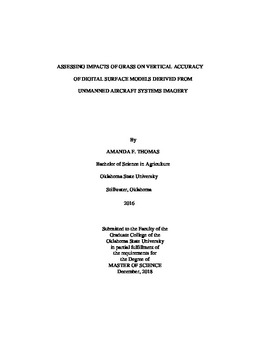| dc.contributor.advisor | Frazier, Amy E. | |
| dc.contributor.author | Thomas, Amanda Fae | |
| dc.date.accessioned | 2019-07-19T14:49:25Z | |
| dc.date.available | 2019-07-19T14:49:25Z | |
| dc.date.issued | 2018-12-01 | |
| dc.identifier.uri | https://hdl.handle.net/11244/321001 | |
| dc.description.abstract | Digital surface models (DSM), which are 3D representations of the Earth's surface including all natural and built features, can be created many ways, including directly through lidar acquisitions or indirectly through photogrammetric manipulation of aerial imagery. DSMs created using aerial imagery collected via unmanned aircraft systems are prone to having high elevation error in places with vegetation, because the photographs capture only the top-most surface and do not penetrate to the underlying topography. While many studies have acknowledged this error, few have quantified its magnitude and extent especially for areas involving wild grasses or areas of drastic elevation change. While a distinct correlation between grass height and DSM vertical accuracy was not found, this study assesses possible reasons for model inaccuracy and possible future improvement. | |
| dc.format | application/pdf | |
| dc.language | en_US | |
| dc.rights | Copyright is held by the author who has granted the Oklahoma State University Library the non-exclusive right to share this material in its institutional repository. Contact Digital Library Services at lib-dls@okstate.edu or 405-744-9161 for the permission policy on the use, reproduction or distribution of this material. | |
| dc.title | Assessing Impacts of Grass on Vertical Accuracy of Digital Surface Models Derived from Unmanned Aircraft Systems Imagery | |
| dc.contributor.committeeMember | Mathews, Adam J. | |
| dc.contributor.committeeMember | Cordova, Carlos E. | |
| osu.filename | Thomas_okstate_0664M_16024.pdf | |
| osu.accesstype | Open Access | |
| dc.description.department | Geography | |
| dc.type.genre | Thesis | |
| dc.type.material | Text | |
